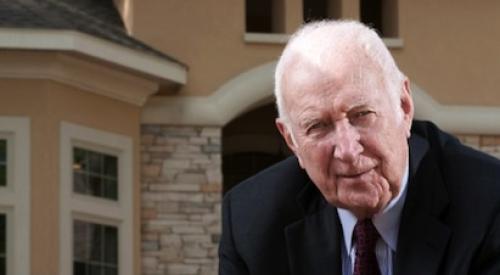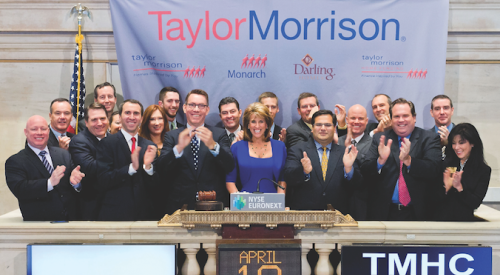Rutenberg began selling franchises on Florida's west coast in 1986, the year Professional Builder honored him as Builder of the Year. His franchise network grew slowly during the next 17 years, trapped in the state where the Rutenberg name has brand identity.
In the go-go 1990s, large production builders scoffed at franchising as a growth strategy with limited profit potential. Those with grandiose plans instead gravitated toward Wall Street. Initial public offerings are sexier than riding herd on dozens of small-business owners who might fail. But in today's consolidating home building industry, launching an IPO requires much more critical mass in closings, revenue and geographic diversity than when Don Horton pulled it off with D.R. Horton in 1992.
The competition has changed as well. Huge public builders now invade small markets and broaden their product lines to muscle into price points from entry level to luxury. Suddenly, both private regional GIANTS and local custom builders face national publics as competitors, and franchising has new appeal. Large privates see it as a way to grow, and small local builders see a franchise affiliation as a way to garner some of the attributes of size.
|
|
|
|
Rutenberg began selling franchises on Florida's west coast in 1986, the year Professional Builder honored him as Builder of the Year. His franchise network grew slowly during the next 17 years, trapped in the state where the Rutenberg name has brand identity.
In the go-go 1990s, large production builders scoffed at franchising as a growth strategy with limited profit potential. Those with grandiose plans instead gravitated toward Wall Street. Initial public offerings are sexier than riding herd on dozens of small-business owners who might fail. But in today's consolidating home building industry, launching an IPO requires much more critical mass in closings, revenue and geographic diversity than when Don Horton pulled it off with D.R. Horton in 1992.
The competition has changed as well. Huge public builders now invade small markets and broaden their product lines to muscle into price points from entry level to luxury. Suddenly, both private regional GIANTS and local custom builders face national publics as competitors, and franchising has new appeal. Large privates see it as a way to grow, and small local builders see a franchise affiliation as a way to garner some of the attributes of size.
|
|
|
|
Rutenberg began selling franchises on Florida's west coast in 1986, the year Professional Builder honored him as Builder of the Year. His franchise network grew slowly during the next 17 years, trapped in the state where the Rutenberg name has brand identity.
In the go-go 1990s, large production builders scoffed at franchising as a growth strategy with limited profit potential. Those with grandiose plans instead gravitated toward Wall Street. Initial public offerings are sexier than riding herd on dozens of small-business owners who might fail. But in today's consolidating home building industry, launching an IPO requires much more critical mass in closings, revenue and geographic diversity than when Don Horton pulled it off with D.R. Horton in 1992.
The competition has changed as well. Huge public builders now invade small markets and broaden their product lines to muscle into price points from entry level to luxury. Suddenly, both private regional GIANTS and local custom builders face national publics as competitors, and franchising has new appeal. Large privates see it as a way to grow, and small local builders see a franchise affiliation as a way to garner some of the attributes of size.
|
|
|
|
Rutenberg began selling franchises on Florida's west coast in 1986, the year Professional Builder honored him as Builder of the Year. His franchise network grew slowly during the next 17 years, trapped in the state where the Rutenberg name has brand identity.
In the go-go 1990s, large production builders scoffed at franchising as a growth strategy with limited profit potential. Those with grandiose plans instead gravitated toward Wall Street. Initial public offerings are sexier than riding herd on dozens of small-business owners who might fail. But in today's consolidating home building industry, launching an IPO requires much more critical mass in closings, revenue and geographic diversity than when Don Horton pulled it off with D.R. Horton in 1992.
The competition has changed as well. Huge public builders now invade small markets and broaden their product lines to muscle into price points from entry level to luxury. Suddenly, both private regional GIANTS and local custom builders face national publics as competitors, and franchising has new appeal. Large privates see it as a way to grow, and small local builders see a franchise affiliation as a way to garner some of the attributes of size.
|
|
|
|
Here are just a few of the factors favoring franchising:
1. No-risk growth. Management guru Lee Evans used to say, "Stay in this business long enough, and you'll go broke!" His advice: Cash out every five years, especially when down cycles loom. But franchising offers an alternative: Stay in business and keep growing, but make money from franchise fees while the franchisees shoulder the risk of land-acquisition loans.
2. Buying power. Franchisers and franchisees (and home buyers) benefit from negotiating pricing agreements with product and materials vendors as a larger-scale operator, buying hundreds of appliances and cabinets rather than the dozens that small companies with no collective clout buy.
3. MIS muscle. Small builders are at a distinct disadvantage in management information systems when competing with national public builders, but a franchise network gives them the critical mass to afford computing power that matches - and in some cases exceeds - that of the big boys.
4. Entrepreneurial zeal. Independent entrepreneurs bring enthusiasm and sweat equity to the collective entity. With their capital invested in the business and their signatures on the loans, they'll outwork national builders' salaried division managers - as long as the franchise agreement creates a solid return on investment.
5. Collective best practices. Get franchisees to-gether, and ideas about im-proving operations spread like wildfire. Can national public builders get the same results from executives competing for promotion?
What It Costs
Franchise fees in the networks we know range from 1% of revenue to 4%, but they're usually paid over a schedule that includes a five-figure initiation fee and regular payments thereafter, usually related more to construction starts than closings. A franchisee also can count on having to get a line of credit from a lender that will require 10-30% down as well as seed money of up to $200,000 to establish an office, hire employees and get started. So it's not for kids out of college. In fact, many new franchisees must tap equity investors to get in the game.
Moreover, established franchise networks bring new franchisees into the system selectively. Expect background checks and long interviews.
Three franchise networks now operate with high profiles in the home building industry: Arthur Rutenberg Homes, Epmark Inc. and Inland Homes Group.











